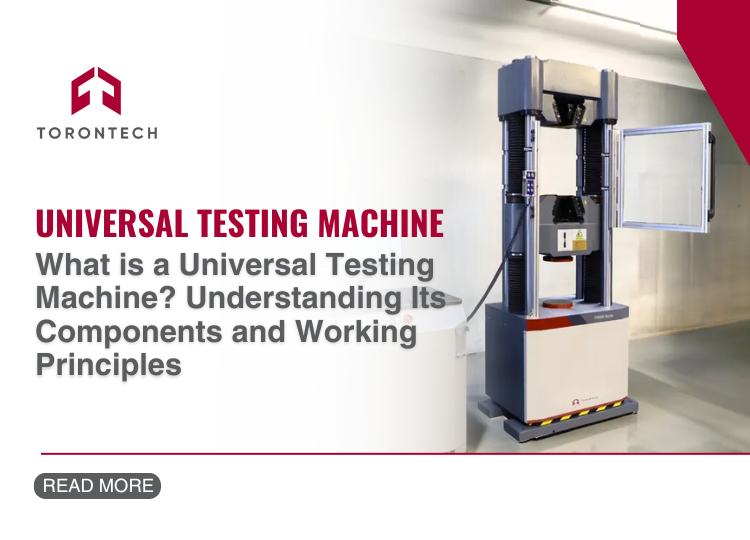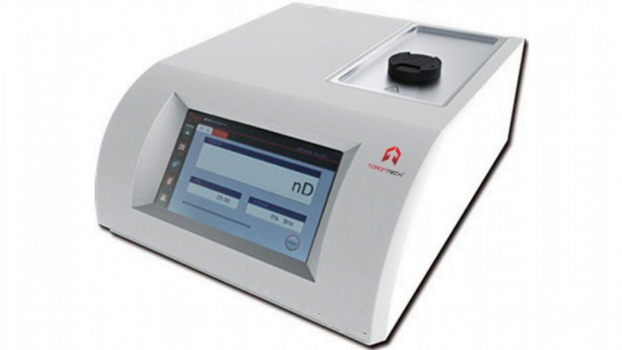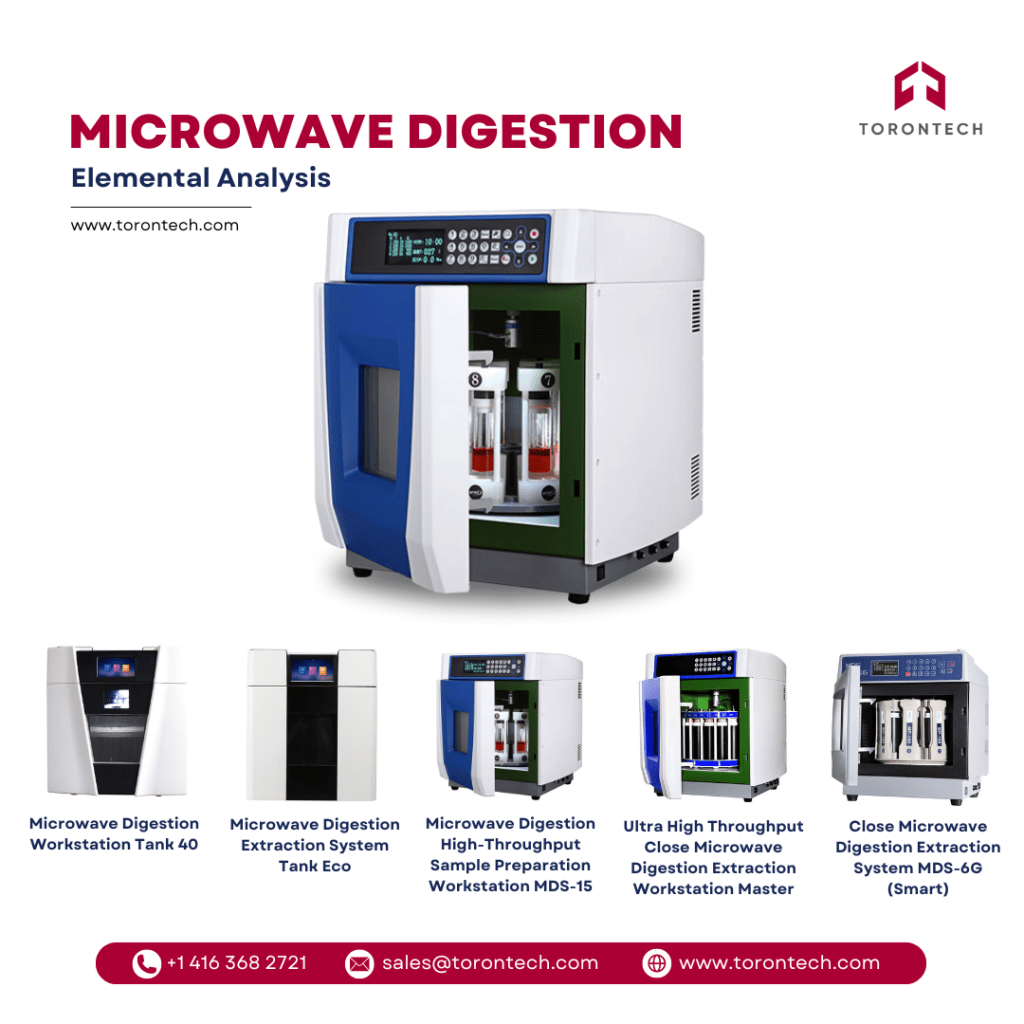If you work in material testing, you know how important it is to ensure products meet safety and quality standards. A Universal Testing Machine (UTM) helps you do just that. Whether you’re testing metals, plastics, rubber, or composites, this machine measures tensile strength, compression resistance, and flexural properties.
But how does a Universal Testing Machine work, and what makes it so essential in industries like aerospace, construction, and manufacturing? This guide breaks it all down for you.
What is a Universal Testing Machine?
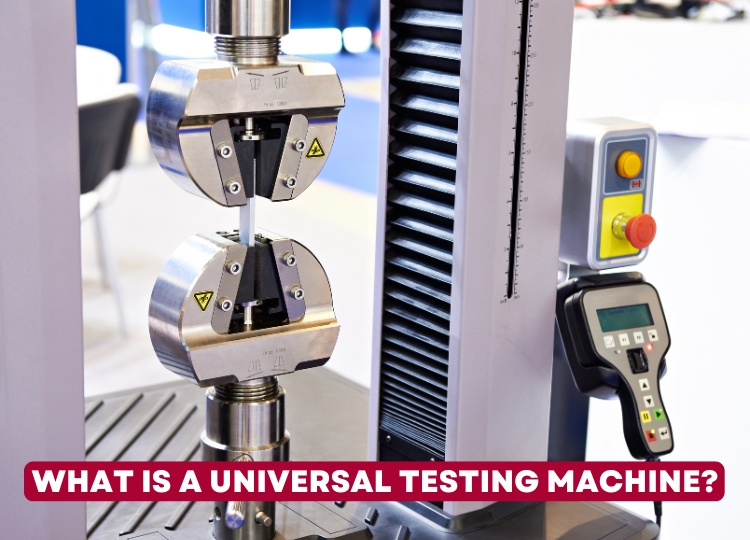
A Universal Testing Machine is a versatile mechanical testing system designed to evaluate the strength, durability, and flexibility of various materials. Whether you need to measure tensile strength, compression resistance, or bending properties, this machine applies controlled force and displacement to assess a material’s mechanical behavior with precision.
Universal Testing Machines can go by other names, including UTM machine, universal tensile testing machine, tensile tester, and tensile strength testing machine. Despite the variations in terminology, they all serve the same purpose, ensuring materials meet quality and safety standards through rigorous testing.
The term “universal” reflects the machine’s ability to perform multiple types of tests using the same system. With the right accessories, a UTM can conduct tensile, compression, flexural, peel, shear, and puncture tests, making it a critical tool in quality control, research, and product development across various industries.
What Test Can Be Performed on a Universal Testing Machine?
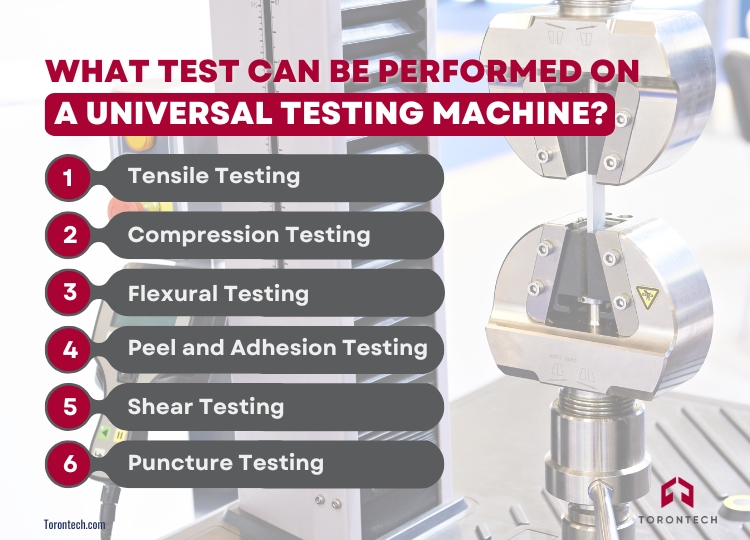
One of the key advantages of a Universal Testing Machine is its ability to perform a wide range of mechanical tests, including:
- Tensile Testing: Determines a material’s maximum tensile strength and elongation before failure.
- Compression Testing: Measures how well a material withstands compressive force without deforming or breaking.
- Flexural Testing: Evaluates a material’s bending resistance, often used for plastics, composites, and construction materials.
- Peel and Adhesion Testing: Assesses the bonding strength between layers of materials, common in packaging and coatings.
- Shear Testing: Examines how a material responds to forces that cause layers to slide past each other.
- Puncture Testing: Determines a material’s resistance to penetration, often used in films, membranes, and textiles.
Industries such as aerospace, automotive, construction, and manufacturing depend on Universal Testing Machines to ensure materials comply with ASTM, ISO, and other international standards. From verifying the structural integrity of metal components to assessing the flexibility of plastic products, UTMs help manufacturers maintain product reliability and performance.
But how does a Universal Testing Machine actually work? Let’s explore its working principle and test process in the next section.
How Does a Universal Testing Machine Work?
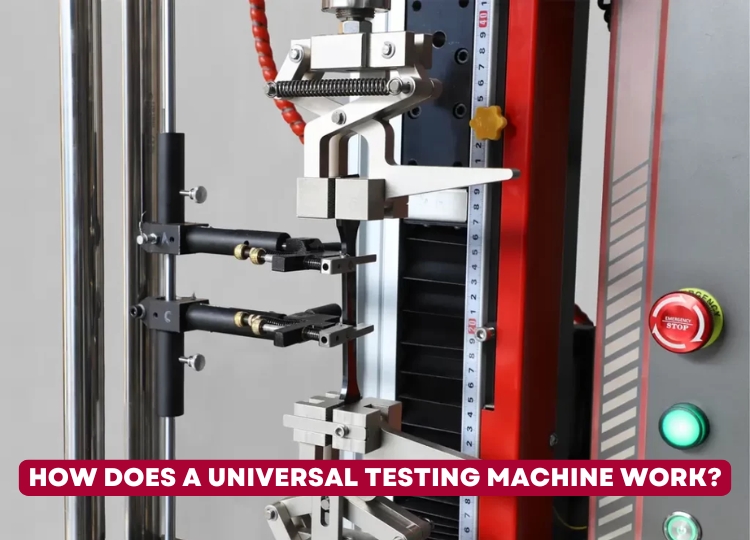
A UTM Machine operates by applying controlled force to a test specimen while measuring its response to stress and strain. The process provides critical data on tensile strength, compression resistance, elasticity, and failure point, helping you evaluate a material’s mechanical behavior with precision.
When the start button is pressed, the system triggers the input pin, activating the attached extensometer to begin recording test readings.
Think about how you stretch a rubber band with your hands, it’s easy to see how it elongates and deforms under force. But what if you needed to test something much stronger, like iron, copper, or composite materials?
That’s where a Universal Testing Machine (also known as a universal tester) comes in, applying precise and repeatable forces that human hands simply can’t achieve.
Load Capacities and Testing Ranges
Depending on the material and test type, UTMs can operate at different load capacities, typically ranging from 300 kN to 1,000 kN or more, to accommodate both soft and rigid materials.
- Low-capacity UTMs (up to 50 kN): Ideal for plastics, rubber, textiles, and biomaterials.
- Medium-capacity UTMs (50 kN – 300 kN): Used for metals, composites, and construction materials.
- High-capacity UTMs (300 kN – 1,000 kN): Designed for heavy-duty testing, such as structural steel, concrete, and aerospace components.
Key Components of a Universal Testing Machine
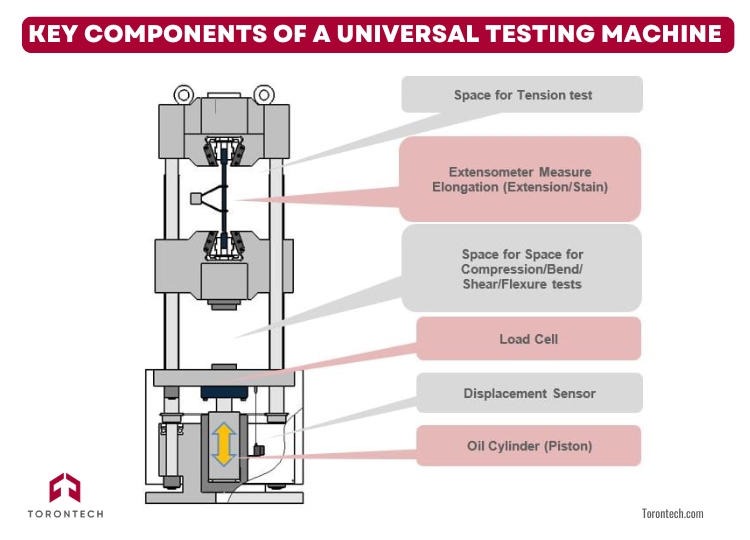
A UTM Machine consists of several key components that work together to apply force, measure material properties, and generate accurate test data. Below is a breakdown of the essential components of a UTM and their functions.
1. Load Frame: The Backbone of a UTM
The load frame is the main structure of the UTM, providing the rigid support needed to apply force without excessive movement or distortion. It consists of:
- Base (Bottom Crosshead) – Houses the actuator or drive system that moves the crosshead.
- Vertical Columns – Support the moving crosshead and ensure alignment.
- Upper Crosshead – Holds the fixed grip or fixture in place.
The load frame’s capacity varies, with models ranging from low-force systems for plastics and films to high-force machines exceeding 1,000 kN for industrial materials like steel and concrete.
2. Crosshead: Controlling Movement
The crosshead moves up and down along the vertical columns, applying either tensile (pulling) or compressive (pushing) force on the specimen.
- Adjustable Speed – The crosshead speed can be controlled to meet test requirements.
- Electromechanical or Hydraulic Drive – Determines how force is applied.
For tensile tests, the crosshead pulls the sample from both ends until it fractures. For compression tests, it pushes downward to evaluate how the material withstands pressure.
3. Load Cell: Measuring Applied Force
The load cell is a high-precision sensor that measures the force applied to the test specimen. It converts mechanical force into an electrical signal, which is then displayed in real-time by the UTM software.
Load cells come in different capacities based on the maximum force rating of the UTM. Using the wrong load cell can lead to inaccurate readings or damage to the equipment.
4. Grips & Fixtures: Holding the Specimen Securely
Different materials require specialized grips and fixtures to hold the test specimen in place without slippage or premature failure. Common types include:
- Wedge Grips – Used for high-strength metals and composites.
- Pneumatic Grips – Provide uniform clamping pressure for delicate materials.
- Compression Platens – Flat plates designed for testing concrete, rubber, and other compressible materials.
- Bending Fixtures – Used for flexural tests on plastics, wood, and ceramics.
The correct grip selection ensures that force is applied evenly, preventing misalignment and inaccurate test results.
5. Extensometer: Measuring Deformation & Strain
An extensometer is an optional attachment that precisely measures elongation and strain during a tensile or compression test. It provides more accurate displacement readings than the crosshead alone.
- Clip-on Extensometers – Attached directly to the specimen for high-accuracy measurements.
- Non-Contact Extensometers – Use lasers or video tracking to measure strain without touching the sample.
6. Drive System: Powering the UTM
The drive system determines how force is applied to the specimen. UTMs generally use one of the following:
- Electromechanical Drive – Uses a servo motor and ball screw system for precise control of force application. Ideal for low-to-medium force tests.
- Hydraulic Drive – Uses fluid pressure to apply high forces, making it ideal for testing metals, concrete, and large structural components.
Electromechanical systems are preferred for high-precision, low-force applications, while hydraulic systems are used in heavy-duty material testing.
7. Control Panel & Software: Managing the Test Process
The control panel and software allow the operator to:
- Set test parameters like load rate and displacement speed.
- Monitor force and strain in real-time.
- Analyze test data and generate reports.
Modern UTMs come with touchscreen interfaces and PC connectivity, enabling automated test execution and compliance with ASTM, ISO, and other industry standards.
Closing Thoughts
Material failure can lead to costly rework, safety risks, and compliance issues, which is why accurate mechanical testing is critical. A Universal Testing Machine ensures that materials meet strength and durability requirements before they are used in real-world applications.
From determining tensile properties in metals to testing flexural strength in polymers, a high-quality UTM provides the data manufacturers and researchers need to maintain product integrity. Working with reliable universal testing machine suppliers ensures that your testing system is precise, durable, and compliant with global standards.
For laboratories and production facilities looking for high-performance testing solutions, Torontech offers a comprehensive range of Universal Testing Machines designed for different load capacities and applications.
Whether you need electromechanical or hydraulic systems, our UTMs provide precise force application, advanced software integration, and durable construction. Explore our selection and find the right system for your needs.
Frequently Asked Question (FAQ)
2. We test a diverse range of materials. Can a single UTM handle all our testing needs?
Yes, that's precisely what the "Universal" in UTM stands for, but the key is proper configuration. A single UTM frame can test everything from flexible films to rigid metals, provided it's equipped with the right load cell capacity and the appropriate grips and fixtures for each test type. At Torontech, we specialize in helping our clients build a versatile testing system, guiding you through selecting the right machine and accessories from our comprehensive range to ensure you can confidently test all your materials on one platform.
3. What are the critical business factors when choosing between an electromechanical and a hydraulic UTM?
The choice depends entirely on your application's force requirements. Electromechanical UTMs offer high precision and control, making them ideal for lower-force tests on materials like plastics, textiles, and elastomers. Hydraulic UTMs are powerhouses designed for high-force applications, such as testing the tensile strength of metals, rebar, and concrete. We guide our clients through this decision by analyzing their current and future testing needs to ensure they invest in the system that provides the right balance of power, precision, and cost-effectiveness for their specific industry.
4. How does a UTM help our company meet critical industry standards and reduce liability?
A UTM is fundamental for meeting standards like ASTM and ISO because it provides the objective, traceable data required to certify your materials. By proving that your products meet or exceed specified strength and durability requirements, you build a robust quality record that is essential for passing audits, entering new markets, and defending against liability claims. Our UTMs are engineered to perform these tests with the precision needed to ensure your compliance documentation is always accurate and defensible.
5. Why is our choice of a UTM supplier as important as the machine itself?
Your choice of supplier is critical because a UTM is a long-term asset central to your quality assurance. You need a partner who provides more than just hardware. At Torontech, we believe our role is to ensure your long-term success. We do this by delivering robust, reliable machines engineered for accuracy and durability, and by providing expert support to help you with application questions, training, and maintenance. We partner with you to make sure your UTM remains a valuable and reliable cornerstone of your quality system for years to come.

